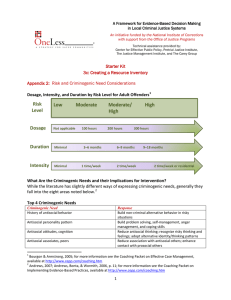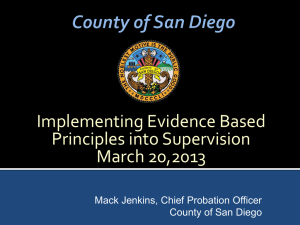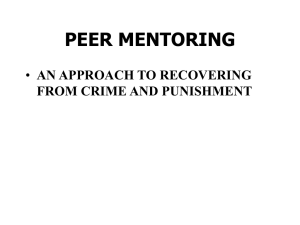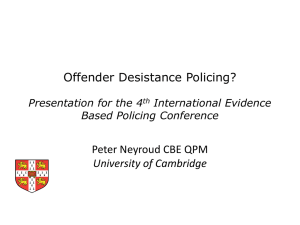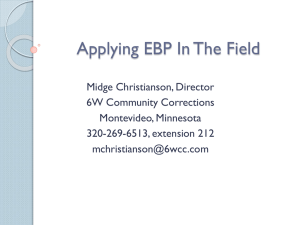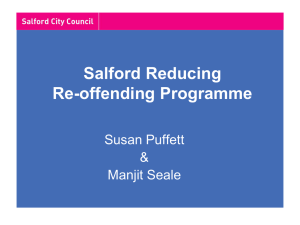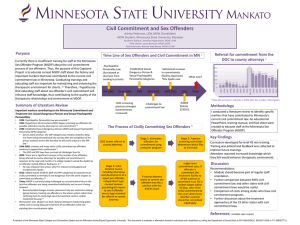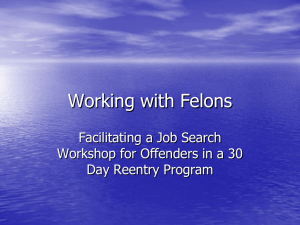Conference Slides (powerpoint)
advertisement
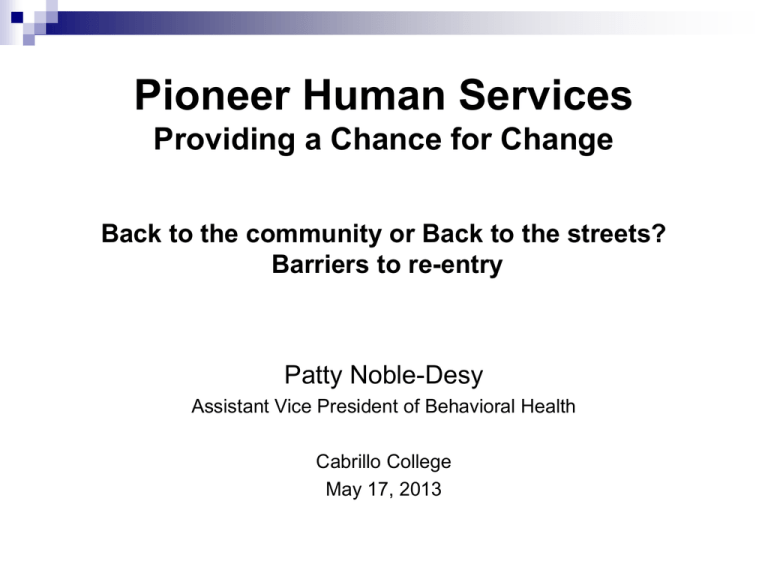
Pioneer Human Services Providing a Chance for Change Back to the community or Back to the streets? Barriers to re-entry Patty Noble-Desy Assistant Vice President of Behavioral Health Cabrillo College May 17, 2013 Let’s talk about…… You and a bit about me Prison and the people and who live there What happens and what doesn’t happen The Buzz killers back home What works and what doesn’t The Pioneer Story When the prison gates slam behind an inmate, they do not lose their human quality; their mind does not become closed to ideas; their intellect does not cease to feed on a free and open interchange of opinions; their yearning for self-respect does not end; nor is their quest for self realization concluded. If anything, the needs for identity and selfrespect are more compelling in the dehumanizing prison environment. Thurgood Marshall (Purocunier v. Martinez, 416 U.S. 396 (1974) 3 Record Number of Offenders in US In 2007, the correctional population in the US reached a new record of 7.3 million offenders. Bureau of Justice Statistics © 2010 Return to custody 30% return within 6 months 44% return within 1st year 67% return within 3 years The People 1/29 black males are incarcerated 1/86 Hispanic males are incarcerated 1/223 white males are incarcerated 1/3 of incarcerated persons were unemployed at arrest 50% of people of color were unemployed at arrest 60% have less than HS diploma 7% of Black children have a parent in total confinement 2% of all other children 6 Corrections is often the final stop on the downward physical, psychological and social spiral that hijacks the lives of many of society’s most vulnerable individuals Prison is often the institution of last resort for the poor, the mentally ill, the addicted, the poorly educated, unemployed, people of color Behind Closed Doors Trauma and chains Poor nutrition and Sleep deprivation Cages – Isolation- Separation Idleness Extortion (phone kick-backs) A Medicated offender is an easy keeper (13% vs. 60-80%) Total loss of privacy The rest of the story Institutional personality disorders Oppressive environments Passive compliance to demands of authorities Severely restricted acts of daily living Elimination of critical thinking & decision making Restrictions on self expression of thoughts and feelings Reinforcing negative self belief patterns Reduction and elimination of programs When Prisoners Come home 95% of the 1,4 million inmates will return home at the rate of 1600 per day across the USA 44% within 1 year of incarceration These are mostly men of color from inner cities No housing or job Those leaving are Poorly educated Lack job or vocational skills Struggle with addiction and mental illness Loss of family or other pro social supports 80% substance issues – 60-70% addicted 13% SMI 50 % COD Post Incarceration Syndrome If it were not for Alcohol and other drugs 60% of those currently incarcerated in the US could go home 20% of violent crimes are committed under the influence Consequences of Crime Related to Substances Bureau of Justice Statistics report in 1999 alone, 12,658 homicides- 4.5 of all homicides for that year were drug related Office of National Drug Control Policy in 2001 estimate the total crime related coasts of drug abuse were more than $100 million in 2000 Research consistently demonstrates a strong connection between crime and addiction 84% of state prison inmates were involved with alcohol or other drugs at the time of their offense 45% were under the influence when the crime was committed 21% report they committed their crime for money to buy drugs 64% of male arrestees tested positive for at least one of five illegal drugs at arrest 57% report binge drinking in the 30 days prior to arrest another 36% report heavy drinking The Criminogenic Addict Commits over 70% of all offenses Commits 15 times as many robberies as non-drug using offenders Commits 10 times as many thefts Commits 20 times as many burglaries Crime rate is 4-6 times higher Three chronically relapsing disorders 1. addiction 2. mental illness 3. criminal behavior 15 Mentally Ill in Criminal Justice 50 40 % 30 Jail 16.3% State prison 16.2% Probation 16.0% 20 Federal prison 7.4% 10 0 *reported either a mental or emotional condition or an overnight stay in a mental hospital or program Source: Ditton, P.M., 1999. CIRP 10/12/2006 3 Addiction is a primary, chronic, neurobiological disease characterized by behaviors that include one or more of the 3 C’s Impaired Control over drug use Early social/recreational use Eventual loss of control Cognitive distortions (“denial”) Compulsive use Drug-seeking activities Continued use despite adverse consequences Chronicity Natural history of multiple relapses preceding stable recovery Possible relapse after years of sobriety Given the severity of the addiction problem and the absolute essential and critical need to fully intervene on all offender behavior, the states and communities must reconsider its current practices and approaches to behavioral and custodial interventions for offenders. The failure to comprehensively address the integrated addiction, mental and social disorganization of the CJ population will simply result in the continued recycling In the absence of treatment, 75% of released, addicts will return to crime within 30 days of release to the community. (NIDA; 2003) Others will die, quickly, and the rest will die slowly and at great community cost. The Home Going and the Buzz Busters Gate Money Clothing Transportation – County of Origin Medication Housing Burnt Bridges- children and family Employment NIMBY where do you think they came from? The keys to re entry HOME- JOB- FRIEND A do over-- permanent records Belonging support system Integration does not mean assimilation Community Support Continued treatment Promising Community Practices Sentencing Alternatives- Reform Sobering centers/wet housing/ Shelter + Care Re entry and problem solving courts Judicial Community Supervision Community College education and treatment on campus Social Enterprise Appropriate integrated treatment Faith Based The Pioneer Story Jack Dalton Pioneer Fellowship House 805 housing units 20,000 individuals touched annually Treatment Job Training Employment 44,000 parts for Boeing Evidence Based Principles of Offender Rehabilitation 1. Assess Actuarial Risk/Needs 2. Enhance Intrinsic Motivation. 3. Target Interventions. a. Risk Principle b. Need Principle c. Responsivity Principle d. Dosage 4. Skill Train with Directed Practice (use Cognitive Behavioral treatment methods). 5. Increase Positive Reinforcement. 6. Engage Ongoing Support in Natural Communities. 7. Measure Relevant Processes/Practices. 8. Provide Measurement Feedback. National Institute of Corrections & Crime and Justice Institute, (2003) Criminogenic Need Principle Criminogenic needs are dynamic risk factors that, when addressed or changed, affect the offender’s risk for recidivism. Criminogenic needs contribute to or covary with criminal behavior. Central Eight Criminogenic Needs Andrews, Bonta & Wormith, (2006) identified what are referred to as the “central eight” criminogenic needs. 1) Antisocial attitudes/orientation 2) Antisocial peers 3) Antisocial personality 4) Antisocial behavior patterns 5) Absence of pro-social leisure/recreation activities 6) Dysfunctional family 7) Employment issues 8) Substance abuse problems Antisocial Attitudes/Orientation Values, beliefs, attitudes, and cognitions relative to criminal conduct and pro-social alternatives are strongly correlated with criminal behavior, (Andrews, Bonta & Wormith, 2005). Antisocial Peers Antisocial support network reinforces the behavior, attitudes, orientation, definitions, and technology favorable to committing criminal acts. Antisocial peers and affiliating with security threat groups/gangs is one of the single best predictors of criminal behavior (Andrews, Bonta & Wormith, 2005). Antisocial Personality Callousness, risk taking, weak self-control, and high antagonism have been directly linked to criminality, (Andrews, Bonta & Wormith, 2006). Offenders displaying antisocial personality traits often do not care how their actions affect others and do not feel remorse. Absence of Pro-Social Leisure/Recreation Activities In the absence of constructive and rewarding participation in pro-social activities, offenders with antisocial personality characteristics (e.g., high sensation seeking, substance use, impulsivity) typically gravitate towards pursuits that are incongruent with lawful behavior and pro-social development. Dysfunctional Family The absence of healthy family socialization and role models early on in life can have lasting detrimental effects, including ineffectual parenting, child abuse, family violence, and weak parent/child attachments. Many offenders have never experienced interpersonal support for pro-social behavior. Family and significant others frequently serve vicariously or deliberately to reinforce antisocial behavior and shun pro-social convention. Employment Employment is a primary socialization structure in our culture that provides a crucial source of social bonds. Poor education/employment performance, as measured by the LSI-R, has been strongly correlated with recidivism, (Andrews, Bonta & Wormith, 2006). Risk Principle Prioritize primary supervision and treatment resources for offenders who are at higher risk to re-offend. Shifting program and personnel resources to focus more on higher risk offenders promotes harm-reduction and public safety. Risk Level: Triage Low Risk Offender – has more favorable pro-social thinking and behavior than other risk levels. Divert to administrative supervision. 34 In Treating Addiction… We Need to Keep Our Eye on the Real Target Reducing Addiction Reduces Crime 300 255.1 Mean Crime-Days Per Year at Risk 250 200 74.6% Decline 150 100 64.8 50 0 When Addicted In Remission 36Addiction Status Treatment Works 64% decrease in arrests one year after release for those who complete treatment in prison and in the community $1 invested in drug treatment for offenders yields a $7 savings in future costs Coerced treatment has the same outcome as voluntary admission Addiction treatment of offenders has the greatest cost and social outcome than any other single benefit Treatment Improvement Protocol 44, US Department of Health and Human Service Drug Abuse Treatment Core Components and Comprehensive Services Medical Financial Housing & Transportation Core Treatment Intake Assessment Child Care Treatment Plans Group/Individual Counseling Abstinence Based Pharmacotherapy Mental Health Urine Monitoring Case Management Continuing Care Self-Help (AA/NA) Family AIDS / HIV Risks Vocational Legal Etheridge, Hubbard, Anderson, Craddock, & Flynn, 1997 (PAB) Educational Best Treatment Practices for CJ Popultion Lengthy period of intervention High level of structure and accountability Flexibility Regular evaluation and program correction Coordinated community based outpatient Best Practices • MOTIVATIONAL INTERVIEWING • APPLYING THE STAGES OF CHANGE • CONTINUUM OF CARE AND MATRIX MODEL • CONTINGENCY MANAGEMENT • COGNITIVE BEHAVIORAL THERAPY • THERAPEUTIC COMMUNITY (TC) Barriers to quality care Use of funds 50 Billion on corrections annually 4-6% of state budget 1-3% of corrections budget spent on treatment The research has provided a conceptual framework for developing effective correctional interventions based on three factors: Risk Need Responsivity Risk - states the most intensive and multifaceted interventions should be reserved for highest risk offenders. Need - states that criminogenic factors must be targeted for effective treatment with this population. Substance abuse is a primary criminogenic factor. “Responsivity” or Treatment Matching the treatment approach used should.. “closely fit with the offender’s characteristics, orientation and overall interpersonal style” Principles of Effective Intervention Programs should be intensive and behavioral in nature. Programs should target known predictors of crime. Behavioral programs will use standardized assessments to identify the risk level, need level, and responsivity issues of offenders. Programs should match the characteristics of the offender, therapists, and program. Program contingencies and behavioral strategies should be enforced in a firm but fair manner. Programs should have well-qualified and well-trained staff who can relate to the offenders. Programs should provide relapse prevention strategies. Programs should adhere to a high degree of advocacy and brokerage with other agencies in the community. Andrews & Gendreau, 1994, 1996 Effective Interventions Not Effective Boot Camp Intensive Supervision Generic Case Management Effective Promising Residential TC’s Diversion CBT Moral Reasoning Contingency Management Medications Drug Courts Motivational Interviewing Research Needed Reentry Serious Violent Offender Reentry Initiative (SVORI) StrengthsBased Case Management NIDA Social Learning Theory Social Learning Theory: people learn and adopt new behaviors through positive and negative reinforcement, observation, and skill practice. (Bandura, 1977; 1969) SLT and Psychology of Criminal Conduct have become the nexus of evidence-based principles of offender rehabilitation. The Social Learning Theory A lifestyle change occurs in a social context Negative patterns, attitudes, and roles were not acquired in isolation, nor can they be altered in isolation. Recovery depends not only upon what has been learned but how and where learning occurs. This is the basis for the community as teacher. Learning is active by doing and participating. Self Determination Theory Studies have shown that a person’s perception of what is prompting the change is more important than what is actually prompting the change. According to SDT, staff can increase internal motivation for change by addressing three basic factors: autonomy, competence, and relatedness. Autonomy Autonomy is an individual’s perception of himself or herself as the agent of an action (“I chose to do this”). When people think that they are making changes for their own reasons, they work harder and are more likely to stick with the new behaviors. Too much coercion can undermine internal motivation because it makes people feel they are being manipulated, which in turn makes them less likely to change (Deci and Ryan, 1985). Competence Competence involves beliefs about confidence (“I can do this”). To change, a person needs to believe that change is both important and possible. Helping offenders set realistic goals, talking about personal strengths, and giving positive feedback on small successes can increase his sense of competence. Relatedness Change is more likely when people are available to support the offender. Relatedness: powerful explanation of why people sometimes act against their own selfinterest (Deci and Ryan, 1985). For better or worse, people tend to behave like those with whom they associate. Individuals engage in prosocial behaviors because they are meaningful to others to whom they feel connected. Coerced or Voluntary Treatment Empirical evidence finds coercion does not impair treatment and effectiveness (Sells and Simpson 1976). Persons addicted to drugs need not to be internally motivated at the outset of treatment to benefit from it. In fact, such persons who are legally pressured into treatment often have better outcomes than voluntary clients because they are likely to stay in treatment longer and complete treatment. (Satel, 1999). Coerced addiction treatment typically results in favorable outcomes among criminal populations, with coerced convicts complying as well as those not mandated to treatment (Miller & Flaherty, 2000). Motivation & Outcomes Research demonstrates that a ratio of four positive affirmations for every, (4:1) expression of disapproval/confrontation has a positive effect on behavioral change. Andrews & Bonta, 2006; Gendreau, 1996; Gendreau & Goggin, 1996; Gendreau, Little, & Goggin, 1996;Gendreau & Paparozzi, 1995. Motivation is dynamic - affected by internal and external factors, but internally motivated change usually lasts longer. Benefits of Treatment The average offending addict commits 5 crimes per day 255 crimes per year. In remission, following treatment offending addicts average 64 crime days per year. A 76% decline in crime days. Cost-Effectiveness of Drug Treatment Cost to society of drug abuse = $180 billion/year Treatment is less expensive than incarceration: Methadone maintenance = $4,700/yr Residential /Outpatient tx $7, 700 /yr Imprisonment = $27,000/yr Other studies indicate that every $1 invested in treatment can yield up to $7 in savings.
